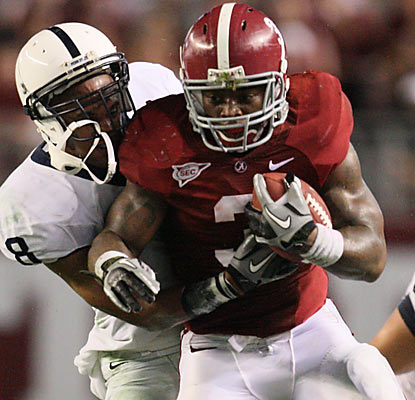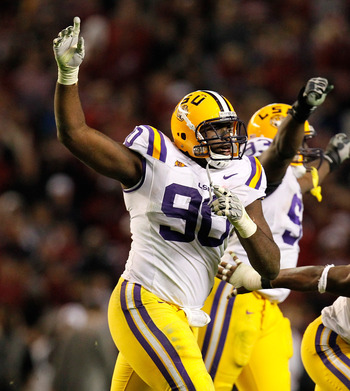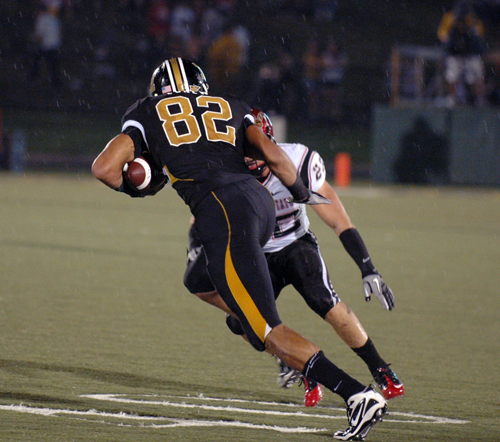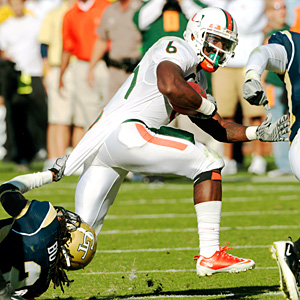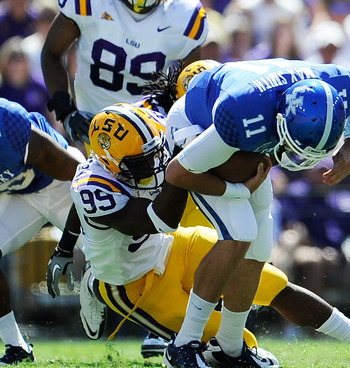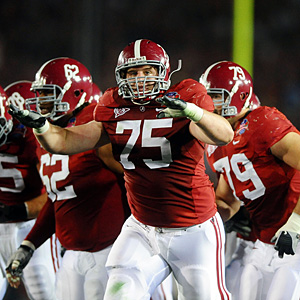
The future?
It was revealed today that Tyler Wilson won’t be entering the 2012 draft and will return to Arkansas. Barring any last minute shocks, we know what’s out there for the Seahawks. Amid all the talk of improving the front seven and especially the team’s pass rush, one need sticks out so much it’ll trip you up. The Seahawks need a quarterback. I started this blog in 2008, and we’ve talked about this subject virtually every week since. Back then it was a case of fixing the roof while the sun was shining – drafting a successor for Matt Hasselbeck before he departed. It started raining, and the house flooded.
The prospect of spending another year talking about quarterbacks is about as tantalising as watching Jim Harbaugh win a Super Bowl. Yet without some bold, ambitious, zany move up the board – that’s exactly what we’re faced with. Andrew Luck and Robert Griffin III will be drafted early and the Seahawks will have to pull out all the stops to get one of the ‘big two’.
After that, well there’s always the possibility players will rise up the board considering the vital nature of the position and how it translates to NFL success. The new rookie wage scale makes drafting a quarterback in round one much less of a gamble, with damaged reputation and pride rather than cap space the main issue. A team can decide to fire a GM for making a bad pick at the position, but they’re going to be able to clean up the mess quite swiftly. We saw last year that team’s are prepared to chance their arm now – there’s no other way to justify a prospect like Christian Ponder going #12 overall.
In my latest mock I included Ryan Tannehill as an early pick after reading Tony Pauline’s report that he’s currently expected to go in the top-15. Like Jake Locker last year, someone could easily take the gamble under the new cap rules. I much preferred Locker if we’re talking comparisons, but many graded the former Washington QB outside of the first round. In the end Tennessee drafted him at #8 – considered a shocking turn of events at the time – and there’s every chance Tannehill will also go in that range whether you agree with that decision or not.
The Washington Redskins pick #6 overall and while they may be better served going in another direction, this is Mike Shanahan’s third draft with the team. In year one he gushed about Sam Bradford, but the #4 pick in 2010 wasn’t high enough to get his man. Last April I fully expected Shanahan to draft Locker at #10 before the Titans stepped in. This year, they might take the hit to get that elusive quarterback. Tannehill shouldn’t go as early as #6 overall, but are you going to risk a third strike and face another year with potentially John Beck or Rex Grossman as your starter? They could take Tennessee’s lead and still add a veteran option to tutor Tannehill and give him time and I maintain Peyton Manning playing in the capital seems like a logical option. If Shanahan doesn’t sort out the position this off season, he’s going to be on the hot-seat.
So with three quarterbacks off the board already, the Seahawks could be left with the scraps at #11 or #12. One option is to just take the situation on the chin, because this is still a team in rebuild with other needs. However, if the goal is sustained improvement it’s unlikely a franchise quarterback is going to one day magically land on a plate. Any quarterback with a modicum of talent is going to go earlier now that team’s essentially have a financial carte blanche to roll the dice on a franchise quarterback. Is it wrong to believe that if things keep progressing in Seattle, the front office faces an inevitable decision on either a.) reaching for a player or b.) trading up?
Of course, so far this regime has found gem after gem in the later rounds of the draft and free agency. They have the midas touch at the moment and the way they’ve turned around an ageing team going absolutely nowhere fast deserves greater credit on a national scale. However, their record so far at quarterback is poor. Tarvaris Jackson was a convenient choice last off season, but he lurched from good to mediocre to bad in 2011. The Charlie Whitehurst trade is a busted deal, simple as that. The only other fairly significant move was to sign Josh Portis and essentially red-shirt him for a year. Nobody truly knows what he’s capable of, but expecting to find the next UDFA sensation is like expecting to win big on the lottery – not impossible, but excruciatingly difficult.
There are options in this draft beyond round one. Chandler Harnish (Northern Illinois), Ryan Lindley (San Diego State), Austin Davis (Southern Miss) and BJ Coleman (Chattanooga) all carry a degree of intrigue. There are bigger names out there too, such as Brandon Weeden (Oklahoma State). Realistically though are any of these guys going to start next year? Perhaps of greater importance, is it really that much easier to find a starting quarterback in rounds 2-7 if the top players are going to go earlier than ever before?
The Seahawks may have to take a chance. This isn’t a draft full of top end first round talent and the prospective options at #11 or #12 are hardly making the fans in Seattle rub their hands in delight. It’s particularly weak on the defensive line – the other real need area that has been highlighted. Do you take a chance? Have Pete Carroll and John Schneider earned the opportunity to get a first round pick at quarterback wrong and live to tell the tale? Are they prepared to take a chance on a quarterback who might not quite be the second coming of Aaron Rodgers, but has enough talent to upgrade the position beyond Tarvaris Jackson? Enough talent to pull together an offense that blocks better, has some talent at receiver and a running back who, if he re-signs, will be hoping to build on a 2011 season that firmly put him among the league’s best.
Let me take you back to 2008.
A quarterback named Joe Flacco was preparing for the NFL Draft. He’d left Pittsburgh after struggling for starts behind Tyler Palko and moved to Delaware, where he made 22 regular season starts and led a FCS playoff run in 2006. He went to the Senior Bowl and impressed enough to earn a grade in the back-end of round two. Momentum continued to build, other quarterbacks failed to emerge. It was understood the Baltimore Ravens had interest in drafting Matt Ryan with the #8 pick, but when he left the board at #3 they traded all the way down to #26. They then moved back up to #18 to secure their man.
Flacco was raw and his footwork needed major work. Most people said he needed time but when injury and illness ruled out Kyle Boller and Troy Smith respectively, Flacco was in. Baltimore boasted an elite defense, a sound running game and offensive line and the rookie quarterback was able to make some plays, helping his team to the AFC Championship game. He got a lot of help as mentioned, his performances were hit and miss – but he did enough. Flacco’s big arm kept other team’s honest, and he did enough to win Rookie of the Year.
Since then Baltimore have returned to the post season each annually. Flacco hasn’t had it easy, including some heavy criticism as people reflect on his status after four seasons of pro-football. The thing is, he’s never going to be Peyton Manning, Drew Brees, Tom Brady or Aaron Rodgers. In Baltimore though, he only has to be Joe Flacco. Denver, New England and Houston are the three teams standing in the way of a first Super Bowl – and the Ravens have home field advantage. Flacco is far from perfect, he can be rattled at times and he’s not been helped by some bizarre playcalling (see: Seattle, week 10). Yet he does enough consistently to keep getting wins. Sure, he won’t be perfect every game – far from it in fact. But he’s not bad enough to stop Baltimore making the playoffs every year and competing. He doesn’t spoil a good supporting cast.
And this is when we come to Seattle.
Everyone is chasing the next Manning, Brady, Brees or Rodgers. Everyone is also chasing the next tier of Matt Stafford, Philip Rivers, Eli Manning and Ben Roethlisberger (or whoever else you want to include here). The Seahawks don’t necessarily need to keep chasing the holy grail. They may only need their version of Joe Flacco.
Some people will cringe at that because let’s be honest – nobody truly aspires to have Flacco as ‘the guy’. We all dream of the elite passers in the league, the miracle workers. But here’s the reality – Alex Smith was quarterback for not just the NFC West Champions this year, but also the #2 seed in the NFC. He did enough in certain games to get a few W’s – the kind that went begging for the Seahawks under Jackson. The Niners have a lot of talent, but they’re not the elite Ravens on defense. This is Seattle’s primary competition for now.
Carroll and Schneider are building a defense that is starting to look very promising. Potentially, it’s a three-technique and another pass rusher away from being – dare we say it – a force to be reckoned with and feared by the rest of the NFC. The running game has come along nicely as 2011 developed. Doesn’t it all just sound familiar?
The Seahawks are lacking that facilitator, someone who can make enough big plays in a game to get the job done. Maybe it is just 145 yards and a score one week? As long as you win the game, what does it matter? That touchdown could be the game winning drive? Unfortunately, ‘game winning drive’ are not words you can associate with Tarvaris Jackson.
Seattle’s Joe Flacco could be Brock Osweiler. The physical similarities are there – height (6-6 vs 6-8), weight (240lbs vs 240lbs), arm strength and raw potential with room for development. Like Flacco, Osweiler has a grade in that round 2-3 range right now. Flacco actually only started six more regular season games at Delaware than Osweiler has at Arizona State, but there’s a steep difference in opposition quality between the FCS and the PAC-12.
Nobody will ever count Osweiler as the ideal. Nobody will argue he’s the finished article or flawless. Yet anyone who watches the Utah tape from yesterday’s blog article will see there is some legitimate pro-potential. Fran Duffy, associate producer for philadelphiaeagles.com and a former video coordinator at Temple University describes Osweiler as, “(someone) who is going to be a stud in this league. I’m sold. This kid has a howitzer. Osweiler can stick the ball anywhere he wants, and he tries to. (He) puts the ball in tight quarters, sometimes good, some bad. But I like that.”
I tend to agree with this assessment and while there’s plenty to work on, there’s also plenty to work with. The one great difference between Flacco and Osweiler is mobility – extending plays, breaking off runs. Osweiler is a natural athlete with surprising agility that helps him improvise on plays the way Flacco simply can’t. In many ways, Osweiler is the kind of quarterback Seattle has been looking for – ability to run bootlegs, downfield passer with an arm to make all the throws and is able to extend plays. Ultimately though, Seattle’s roster is being set up to accomodate a less than perfect quarterback, simply a good one instead.
A lot of people are going to hate this idea, but I’m putting it out there. The Seahawks could trade down, just like Baltimore in 2008, enabling them to add an extra pick or two later on and then draft Osweiler in the #18-25 range just like the Ravens planned with Flacco. It’d be taking a bit of a risk, but this is the situation while ever Seattle’s not picking in the top five to get at the Andrew Luck’s and Matt Barkley’s. Some will say, “why not wait until round two?” My answer is simple – quarterbacks are going to go earlier and earlier these days. Waiting, hoping and praying will not get it done. Osweiler may never reach elite status as a NFL passer, but if he can be Seattle’s Joe Flacco and do enough to make the Seahawks competitive – isn’t that just the ticket?





